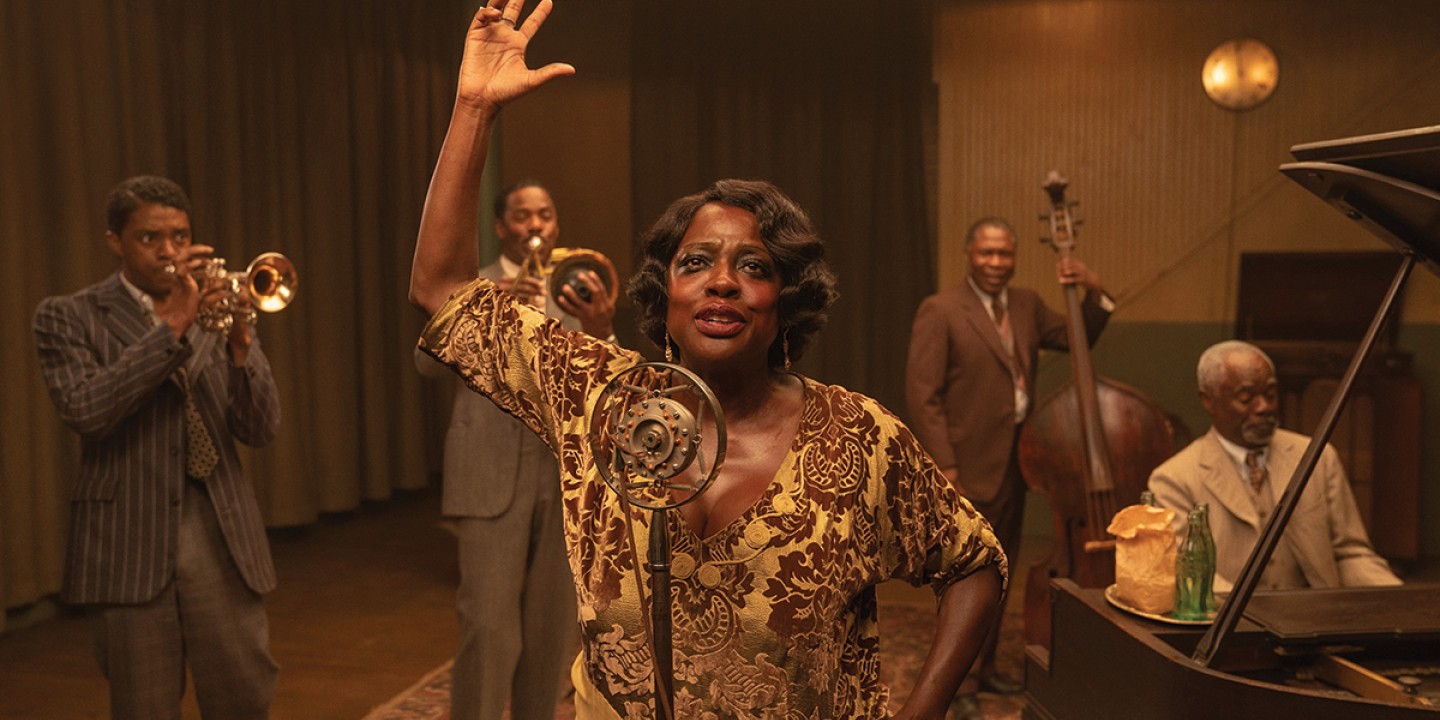The dilemma of Black art in a White-supremacist culture
Set 40 years apart, Ma Rainey’s Black Bottom and One Night in Miami ask similar questions.

“They don’t care nothing about me,” says blues singer Ma Rainey (Viola Davis) in Ma Rainey’s Black Bottom. “All they want is my voice. Well, I done learned that, and they’re going to treat me like I want to be treated no matter how much it hurts them.” She is explaining to her bandleader why she stopped their recording session when her White manager forgot to bring her the Coca-Cola she requested.
In the 1920s, Rainey became one of the first Black women to achieve major fame with White audiences as the “mother of the blues.” In the film, an adaptation of the play by August Wilson, her manager treats her like a spoiled child or capricious tyrant, fluttering about trying to appease her and to keep the studio executive from “putting her in her place.” But Ma knows there is really no difference between the manager’s sycophantic gestures and the executive’s open racism—neither of them cares about her artistry, her inner life, or her experiences. They will drop her the minute she stops making them money.
Read our latest issue or browse back issues.
The film, directed by George C. Wolfe and released by Netflix, is a poignant, masterful exploration of the dilemma of Black art in Jim and Jane Crow America. Ma knows who she is and refuses to compromise. She plays a style of music that made her famous in the Black South, and she won’t pander. But she is challenged by other band members who have a different understanding of the role of music in American racial dynamics. Young, talented trumpeter Levee (Chadwick Boseman, in his last film before his death) thinks he can make music that will catapult him to a new level of fame and popularity with White and northern Black audiences, without losing his identity and artistic freedom.
Whether or not Levee is right becomes a major topic of debate in the film. What is the purpose of Black art and entertainment in a White supremacist culture? All of the musicians feel the pull of music as refuge and release—a way to make meaning, joy, community, and alternative reality for Black audiences. But will this ever lead to actual social change, pianist Toledo (Glynn Turman) wonders? Can Black art tip the scales of justice, or will it be taken over by White artists who will reap more fame and money than the artists from whom they’ve stolen?
These questions are taken up by another new film, set 40 years later at the height of the civil rights movement. One Night in Miami, directed by Regina King and released by Amazon, is also a play turned into a movie. Written for stage and screen by Kemp Powers, it is a fictional account of an actual gathering of Malcolm X (Kingsley Ben-Adir), Sam Cooke (Leslie Odom Jr.), Jim Brown (Aldis Hodge), and Cassius Clay (Eli Goree) on the night in 1964 when Clay became the heavyweight boxing champion of the world.
Turns out, having Malcolm X plan your victory party is a bit of a letdown. The four men end up crammed in a small hotel room with a couple of containers of vanilla ice cream and a lot of time for pointed conversation. In the midst of profound social change, they pick up the debate at the heart of Ma Rainey: Will their excellence in and of itself help tip the scales of racial justice, or are they obligated to use their fame and influence explicitly for the struggle?
Cooke argues that his business acumen and publishing empire are doing as much for “racial uplift” as Malcolm’s public speeches. “You know who gets paid more than the writer of a song that hits number 94 on the Billboard Hot 100?” he says, explaining how he negotiated a deal for a young Black songwriter whose song was covered by the Rolling Stones. “The writer of a song that hits number one.” He has achieved what Levee could only dream of.
Malcolm retorts by playing Bob Dylan’s “Blowin’ in the Wind” and asking how a White boy from Minnesota could give voice to the civil rights struggle more poignantly than any of Cooke’s love ballads. He suggests that Cooke tailors his music so as not to scare away White audiences by seeming too Black.
Because they originated as plays, both movies take place in small, confined spaces—two rooms at a recording studio in Ma Rainey and one hotel room in One Night. With literally no place to go, the actors channel their energy into the dialogue itself, which is in turns explosive and expansive, making philosophical debate about the role of art in social change feel like a sermon, a trumpet solo, and a boxing match all rolled into one.
These debates are still urgent. The Movement for Black Lives has reanimated the question of what role Black athletes, artists, and entertainers play in the work of social justice. Will White-dominant culture ever be transformed, or will it just keep profiting off music, NFL tickets, rap albums, and shoe endorsements? As works of art made by Black artists—writers, directors, actors—these films become part of the history of Black artistry they are portraying. They implicate all of us in the question of whether we will be changed by the art we absorb.
A version of this article appears in the print edition under the title “Can Black art produce change?”







